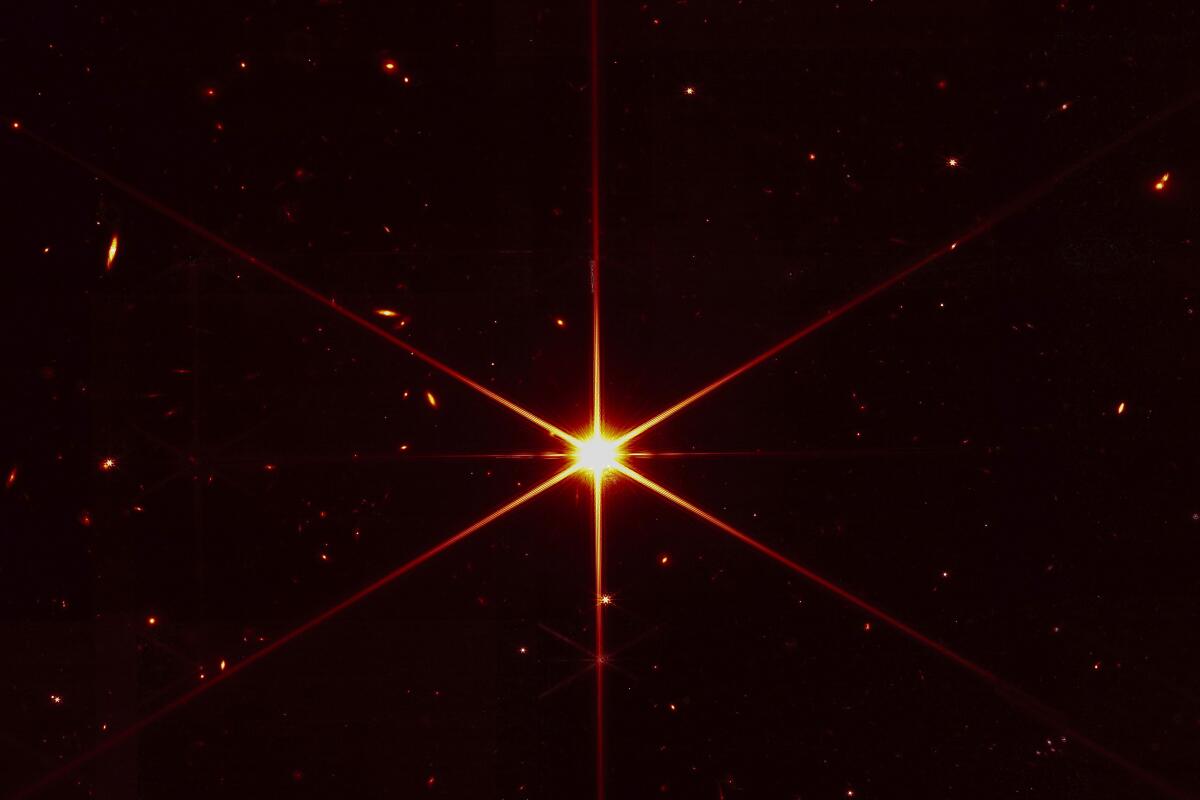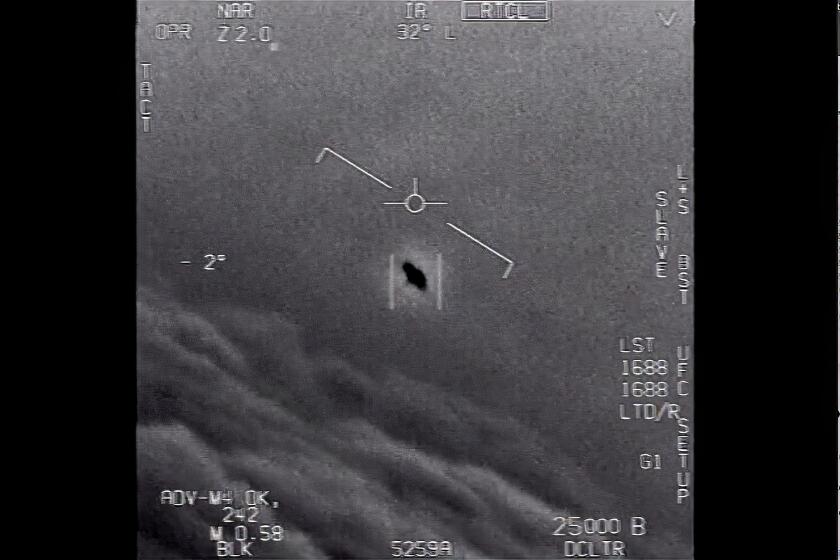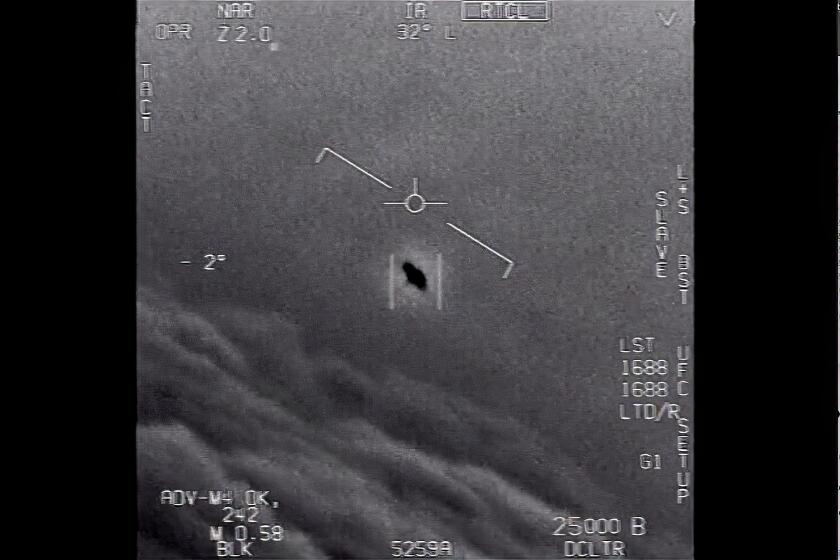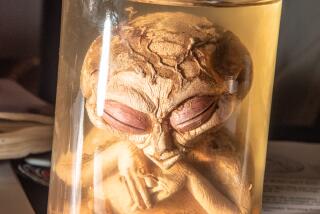Op-Ed: NASA studying UFOs won’t prove alien life exists. They should do it anyway

- Share via
NASA announced this month that its new panel to study Unidentified Aerial Phenomena — i.e. UFOs — was staffed up and ready to get working. The panel is impressive, including planetary scientists, astrophysicists, experts from the Federal Aviation Administration, data scientists and a celebrated astronaut. I have worked with a few of these scientists, and the group represents a stellar collection (pun intended) of smart, creative people with high scientific integrity.
But what, exactly, are these scientists supposed to be doing in the contentious domain of UFOs? More importantly, is this really something that NASA should give time and money, potentially risking the agency’s credibility?
The truth is, this group’s nine-month study is unlikely to determine conclusively what these phenomena are. But NASA’s pursuit can provide a transparent case study of how science is done on a subject full of unknowns. And the discussion can highlight the remarkable progress being made in the scientific search for life on distant planets.
NASA is embarking on a new study on unidentified aerial phenomena, or UAPs — the term scientists use instead of UFOs.
The last few years have brought enormous public attention to Unidentified Aerial Phenomena. In 2020, the Department of Defense caused a stir when it released three videos of Navy jets encountering these phenomena. A preliminary, controversial government report released last year claimed the Navy had seen a variety of UAPs and most could not be easily accounted for. Congress added an amendment to the last defense budget to create a UAP office, which the Pentagon launched this year.
This UFO furor reflects a longer-term cycle of public interest, government attention and eventual lack of clear resolution that’s played out many times since the first widely reported UFO sighting in the U.S. in 1947. Back then the Air Force was concerned that UFOs might be Cold War technology that could be used against us, and the CIA worried that fears of UFOs could be used to drive mass hysteria. In all these cycles deeper exploration showed mundane explanations for most sightings. Those few sightings that couldn’t be explained rarely had the kinds of data that might support firm conclusions about what happened. This, along with the conspiracy-theory inclinations of many UFO enthusiasts, is why most scientists steer clear of the subject.
So what, if anything, has changed now?
The last few decades have seen a revolution in the science of astrobiology, the study of life in the universe. It was led by the discovery of exoplanets, alien worlds orbiting distant stars. When I began my graduate work in the late 1980s, we did not know if any other star hosted even one planet. Now, thanks to spectacular advances in telescope technology, we know that almost every star in the sky is home to a family of worlds. Since life needs planets to form and thrive, this knowledge significantly increases the possibilities of life beyond Earth.
UFOs will get a new government office with needed congressional oversight, thanks to the defense bill.
Even better, the new technologies enable probes of those distant worlds. The search for biosignatures — signs of a biosphere, the parts of a planet where life exists — and technosignatures — signs of intelligence — is taking off. NASA’s James Webb Space Telescope, which launched in December, is only the first among new observatories that will vastly expand the data we collect from worlds light-years away. But any claim that alien life has been found will have to pass through a gauntlet of stringent tests and strident skepticism before the scientific community could accept it.
It’s against this extraordinary progress we’ve made in our scientific search for life that the new NASA panel should be viewed. Its work can demonstrate how science goes about answering questions, especially ones with such high stakes. Given the panel’s short tenure, its chief job — and the first job of any scientific investigation — will be to ask what kinds of data are available. Are that data up to the task of answering the question posed? If not, what kinds of data are needed and what kind of effort is required to get it?
This is how science works. This quest for data that meet tough standards of evidence is the process that gave us cellphones, safe jet travel and drugs that cure formerly intractable diseases. NASA’s panel can begin to lay out what a rational investigation of UFOs looks like without assumptions about what UFOs are. Is a network of Earth-observing satellites required, or upward-looking ground stations? These are some of the questions it may take on.
I would wager that most scientists — including me — overwhelmingly doubt that UAPs have anything to do with life beyond Earth. But a UAP panel can tackle the subject and demonstrate that most beautiful aspect of science: the ability to withhold judgment in favor of evidence. And it can do so with a broader lens than the Pentagon and congressional investigations, which focus on UAPs as a defense issue.
At their best, these efforts can seize upon an issue of great public interest to offer a master class in how science works. For a nation awash in science denial, that would be no small thing. And by creating a blueprint of what evidence is demanded by a question as extraordinary as whether we’re alone in the universe, the panel can show the equally extraordinary progress science is making toward answering it.
Adam Frank is an astrophysicist and professor at the University of Rochester. He is the author of several books, including the upcoming “The Little Book of Aliens.”
More to Read
A cure for the common opinion
Get thought-provoking perspectives with our weekly newsletter.
You may occasionally receive promotional content from the Los Angeles Times.












